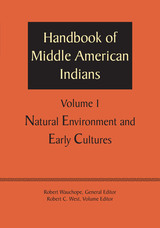
This is the first volume of the monumental Handbook of Middle American Indians, a definitive encyclopaedia of the environment, archaeology, ethnology, social anthropology, ethnohistory, linguistics, and physical anthropology of the native peoples of Mexico and Central America. The Handbook was published in cooperation with the Middle American Research Institute of Tulane University under the general editorship of Robert Wauchope (1909–1979). This volume of the Handbook was edited by Dr. Robert C. West (1913–2001), Boyd Professor of Geography at Louisiana State University, an outstanding authority on Latin America. He was formerly cultural geographer for the Smithsonian Institution.
Included in this first volume are chapters written by leading authorities in various fields of the natural and social sciences that are concerned with the natural environment of Middle America, its role in the shaping of Indian cultures, the earliest primitive hunters of this area, the beginnings of agriculture, and the broad patterns of prehistoric civilizations there.
There are articles on the geohistory and paleogeography of Middle America, its surface configuration and associated geology, hydrography, the American Mediterranean, oceanography and marine life along the Pacific coast, weather and climate, natural vegetation, the soils and their relation to the Indian peoples and cultures, fauna , the natural regions of Middle America, the primitive hunters, the food-gathering and incipient agricultural stage of prehistoric Middle America, origins of agriculture there, and the patterns of farming life and civilization.
The Handbook of Middle American Indians was assembled and edited at the Middle American Research Institute of Tulane University with the assistance of grants from the National Science Foundation and under the sponsorship of the National Research Council Committee on Latin American Anthropology.
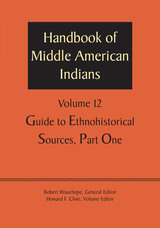
Guide to Ethnohistorical Sources comprises Volumes 12 through 15 of the Handbook of Middle American Indians, published in cooperation with the Middle American Research Institute of Tulane University under the general editorship of Robert Wauchope (1909–1979). The Guide has been assembled under the volume editorship of the late Howard F. Cline, Director of the Hispanic Foundation in the Library of Congress, with Charles Gibson, John B. Glass, and H. B. Nicholson as associate volume editors. It covers geography and ethnogeography, especially the Relaciones Geográficas (Volume 12); sources in the European tradition: printed collections, secular and religious chroniclers, biobibliographies (Volume 13); sources in the native tradition: prose and pictorial materials, checklist of repositories, title and synonymy index, and annotated bibliography on native sources (Volumes 14 and 15).
Volume 12, which is Part One of the Guide, contains the following: “Introduction: Reflections on Ethnohistory,” “Introductory Notes on Territorial Divisions of Middle America,” “Viceroyalty to Republics, 1786–1952: Historical Notes on the Evolution of Middle American Political Units,” “Ethnohistorical Regions of Middle America,” “The Relaciones Geográficas of the Spanish Indies, 1577–1648,” “A Census of the Relaciones Geográficas of New Spain, 1579–1616,” and “The Relaciones Geográficas of Spain, New Spain, and the Spanish Indies: An Annotated Bibliography,” all the foregoing by Howard F. Cline. In addition it includes: “Colonial New Spain, 1519–1786: Historical Notes on the Evolution of Minor Political Jurisdictions” by Peter Gerhard; “The Pinturas (Maps) of the Relaciones Geográficas, with a Catalog” by Donald Robertson; “The Relaciones Geográficas, 1579–1586: Native Languages” by H. R. Harvey; and “The Relaciones Geográficas of Mexico and Central America, 1740–1792” by Robert C. West.
The Handbook of Middle American Indians was assembled and edited at the Middle American Research Institute of Tulane University with the assistance of grants from the National Science Foundation and under the sponsorship of the National Research Council Committee on Latin American Anthropology.
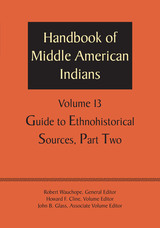
Volume 13 of the Handbook of Middle American Indians, published in cooperation with the Middle American Research Institute of Tulane University under the general editorship of Robert Wauchope (1909–1979), constitutes Part 2 of the Guide to Ethnohistorical Sources. The Guide has been assembled under the volume editorship of the late Howard F. Cline, Director of the Hispanic Foundation in the Library of Congress, with Charles Gibson, John B. Glass, and H. B. Nicholson as associate volume editors. It covers geography and ethnogeography (Volume 12); sources in the European tradition (Volume 13); and sources in the native tradition (Volumes 14 and 15).
The present volume contains the following studies on sources in the European tradition:
- “Published Collections of Documents Relating
- to Middle American Ethnohistory,” by Charles Gibson
- “An Introductory Survey of Secular Writings in the European Tradition on Colonial Middle America, 1503–1818,” by J. Benedict Warren
- “Religious Chroniclers and Historians: A Summary with Annotated Bibliography,” by Ernest J.
- Burrus, S.J.
- “Bernardino de Sahagún,” by Luis Nicolau d’Olwer, Howard F. Cline, and H. B. Nicholson
- “Antonio de Herrera,” by Manuel Ballesteros Gaibrois
- “Juan de Torquemada,” by José Alcina Franch
- “Francisco Javier Clavigero,” by Charles E. Ronan, S.J.
- “Charles Etienne Brasseur de Bourbourg,” by Carroll Edward Mace
- “Hubert Howe Bancroft,” by Howard F. Cline
- “Eduard Georg Seler,” by H. B. Nicholson
- “Selected
The Handbook of Middle American Indians was assembled and edited at the Middle American Research Institute of Tulane University with the assistance of grants from the National Science Foundation and under the sponsorship of the National Research Council Committee on Latin American Anthropology.
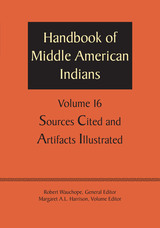
The publication of Volume 16 of this distinguished series brings to a close one of the largest research and documentation projects ever undertaken on the Middle American Indians.
Since the publication of Volume 1 in 1964, the Handbook of Middle American Indians has provided the most complete information on every aspect of indigenous culture, including natural environment, archaeology, linguistics, social anthropology, physical anthropology, ethnology, and ethnohistory.
Culminating this massive project is Volume 16, divided into two parts. Part I, Sources Cited, by Margaret A. L. Harrison, is a listing in alphabetical order of all the bibliographical entries cited in Volumes 1-11. (Volumes 12-15, comprising the Guide to Ethnohistorical Sources, have not been included, because they stand apart in subject matter and contain or constitute independent bibliographical material.) Part II, Location of Artifacts Illustrated, by Marjorie S. Zengel, details the location (at the time of original publication) of the owner of each pre-Columbian American artifact illustrated in Volumes 1-11 of the Handbook, as well as the size and the catalog, accession, and/or inventory number that the owner assigns to the object. The two parts of Volume 16 provide a convenient and useful reference to material found in the earlier volumes.
The Handbook of Middle American Indians was assembled and edited at the Middle American Research Institute of Tulane University with the assistance of grants from the National Science Foundation and under the sponsorship of the National Research Council Committee on Latin American Anthropology.
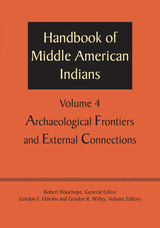
Archaeological Frontiers and External Connections is the fourth volume in the Handbook of Middle American Indians, published in cooperation with the Middle American Research Institute of Tulane University under the general editorship of Robert Wauchope (1909–1979). Volume editors are Gordon R. Willey (1913–2002), Bowditch Professor of Mexican and Central American Archaeology and Ethnology at Harvard University, and Gordon F. Ekholm (1909–1987), Associate Curator of Mexican Archaeology of the American Museum of Natural History in New York.
This volume presents an intensive study of matters of significance in various areas: archaeology and ethnohistory of the Northern Sierra, Sonora, Lower California, and northeastern Mexico; external relations between Mesoamerica and the southwestern United States and eastern United States; archaeology and ethnohistory of El Salvador, western Honduras, and lower Central America; external relations between Mesoamerica and the Caribbean area, Ecuador, and the Andes; and the case for and against Old World pre-Columbian contacts via the Pacific. Many photographs accompany the text.
The Handbook of Middle American Indians was assembled and edited at the Middle American Research Institute of Tulane University with the assistance of grants from the National Science Foundation and under the sponsorship of the National Research Council Committee on Latin American Anthropology.
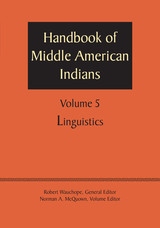
This volume, the fifth in the Handbook of Middle American Indians, presents a summary of work accomplished since the Spanish conquest in the contemporary description and historical reconstruction of the indigenous languages and language families of Mexico and Central America.
The essays include the following: “Inventory of Descriptive Materials” by William Bright; “Inventory of Classificatory Materials” by Maria Teresa Fernández de Miranda, “Lexicostatistic Classification” by Morris Swadesh, “Systemic Comparison and Reconstruction” by Robert Longacre, and “Environmental Correlational Studies” by Sarah C. Gudschinsky.
Sketches of Classical Nahuatl by Stanley Newman, Classical Yucatec Maya by Norman A. McQuown, and Classical Quiché by Munro S. Edmonson provide working tools for tackling the voluminous early postconquest texts in these languages of late preconquest empires (Aztec, Maya, Quiché). Further sketches of Sierra Popoluca by Benjamin F. Elson, of Isthmus Zapotec by Velma B. Pickett, of Huautla de Jiménez Mazatec by Eunice V. Pike, of Jiliapan Pame by Leonardo Manrique C., and of Huamelultec Chontal by Viola Waterhouse—together with those of Nahuatl, Maya, and Quiché—provide not only descriptive outlines of as many different linguistic structures but also linguistic representatives of seven structurally different families of Middle American languages. Miguel Léon-Portilla presents an outline of the relations between language and the culture of which it is a part and provides examples of some of these relations as revealed by contemporary research in indigenous Middle America.
The volume editor, Norman A. McQuown (1914–2005), was Professor of Anthropology at The University of Chicago. He formerly taught at Hunter College and served with the Mexican Department of Indian Affairs. He carried out fieldwork with Totonac, Huastec, Tzeltal-Tzotzil, Mame, and other tribes.
The Handbook of Middle American Indians was assembled and edited at the Middle American Research Institute of Tulane University with the assistance of grants from the National Science Foundation and under the sponsorship of the National Research Council Committee on Latin American Anthropology.
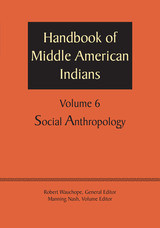
Social Anthropology is the sixth volume in the Handbook of Middle American Indians, published in cooperation with the Middle American Research Institute of Tulane University under the general editorship of Robert Wauchope (1909–1979). The volume editor is Manning Nash (1924–2001), Professor of Anthropology at the Center for Study of Economic Development and Cultural Change, University of Chicago.
This volume provides a synthetic and comparative summary of native ethnography and ethnology of Mexico and Central America, written by authorities in a number of broad fields: the native population and its identification, agricultural systems and food patterns, economies, crafts, fine arts, kinship and family, compadrinazgo, local and territorial units, political and religious organizations, levels of communal relations, annual and fiesta cycles, sickness, folklore, religion, mythology, psychological orientations, ethnic relationships, and topics of especial modern significance such as acculturation, nationalization, directed change, urbanization and industrialization.
The articles rely on the accumulated ethnography of the region, but instead of being essentially historical in treatment, they aim toward generalizations about the uniformities and varieties of culture, society, and personality found in Middle America. The collection is an invaluable reference work on Middle America and a provocative guide to scholars engaged in furthering understanding of humans and society.
The Handbook of Middle American Indians was assembled and edited at the Middle American Research Institute of Tulane University with the assistance of grants from the National Science Foundation and under the sponsorship of the National Research Council Committee on Latin American Anthropology.
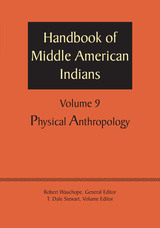
Physical Anthropology is the ninth volume in the Handbook of Middle American Indians, published in cooperation with the Middle American Research Institute of Tulane University under the general editorship of Robert Wauchope (1909–1979). The volume editor is T. Dale Stewart (1901–1997), senior physical anthropologist of the United States National Museum, Smithsonian Institution, former director of its Museum of Natural History, and a past president of the American Association of Physical Anthropologists.
The articles in this volume, together with illustrations, tabular data, bibliographies, and index, constitute an invaluable reference work on the human biology of Middle America and its relationships to human society and culture.
Contents include the following articles:
- “History of Physical Anthropology,” by Juan Comas
- “Preceramic Human Remains,” by Arturo Romano
- “Anthropometry of Late Prehistoric Human Remains,” by Santiago Genovés T.
- “Dental Mutilation, Trephination, and Cranial Deformation,” by Javier Romero
- “Pre-Hispanic Osteopathology,” by Eusebio Dávalos Hurtado
- “Anthropometry of Living Indians,” by Johanna Faulhaber
- “Distribution of Blood Groups,” by G. Albin Matson
- “Physiological Studies,” by D. F. Roberts and Marshall T. Newman
- “Skin, Hair, and Eyes,” a series including “Introduction,” by T. D. Stewart; “Dermatoglyphics,” by Marshall T. Newman; “Hair,” by Mildred Trotter and Oliver H. Duggins; and “Color of Eyes and Skin,” by T. D.
- Stewart
- “Physical Plasticity and Adaptation,” by T. D. Stewart
- “Pathology of Living Indians as Seen in Guatemala,” by Nevin S. Scrimshaw and Carlos Tejada
- “Psychobiometry,” by Javier Romero
The Handbook of Middle American Indians was assembled and edited at the Middle American Research Institute of Tulane University with the assistance of grants from the National Science Foundation and under the sponsorship of the National Research Council Committee on Latin American Anthropology.
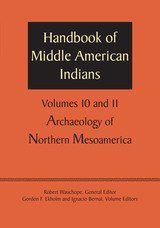
Archaeology of Northern Mesoamerica comprises the tenth and eleventh volumes in the Handbook of Middle American Indians, published in cooperation with the Middle American Research Institute of Tulane University under the general editorship of Robert Wauchope (1909–1979). Volume editors of Archaeology of Northern Mesoamerica are Gordon F. Ekholm and Ignacio Bernal. Gordon F. Ekholm (1909–1987) was curator of anthropology at The American Museum of Natural History, New York, and a former president of the Society for American Archaeology. Ignacio Bernal (1910–1992), former director of the Instituto Nacional de Antropología e Historia, Mexico, was director of the Museo Nacional de Antropología in Mexico and also a past president of the Society for American Archaeology.
Volumes 10 and 11 describe the pre-Aztec and Aztec cultures of Mexico, from central Veracruz and the Gulf Coast, through the Valley of Mexico, to western Mexico and the northern frontiers of these ancient American civilizations.
The thirty-two articles, lavishly illustrated and accompanied by bibliography and index, were prepared by authorities on prehistoric settlement patterns, architecture, sculpture, mural painting, ceramics and minor arts and crafts, ancient writing and calendars, social and political organization, religion, philosophy, and literature. There are also special articles on the archaeology and ethnohistory of selected regions within northern Mesoamerica.
The Handbook of Middle American Indians was assembled and edited at the Middle American Research Institute of Tulane University with the assistance of grants from the National Science Foundation and under the sponsorship of the National Research Council Committee on Latin American Anthropology.
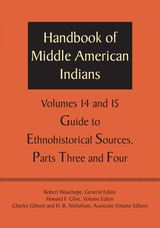
Volumes 14 and 15 of the Handbook of Middle American Indians, published in cooperation with the Middle American Research Institute of Tulane University under the general editorship of Robert Wauchope (1909–1979), constitute Parts 3 and 4 of the Guide to Ethnohistorical Sources. The Guide has been assembled under the volume editorship of the late Howard F. Cline, Director of the Hispanic Foundation in the Library of Congress, with Charles Gibson, John B. Glass, and H. B. Nicholson as associate volume editors. It covers geography and ethnogeography (Volume 12); sources in the European tradition (Volume 13); and sources in the native tradition: prose and pictorial materials, checklist of repositories, title and synonymy index, and annotated bibliography on native sources (Volumes 14 and 15).
The present volumes contain the following studies on sources in the native tradition:
“A Survey of Native Middle American Pictorial Manuscripts,” by John B. Glass
“A Census of Native Middle American Pictorial Manuscripts,” by John B. Glass in collaboration with Donald Robertson
“Techialoyan Manuscripts and Paintings, with a Catalog,” by Donald Robertson
“A Census of Middle American Testerian Manuscripts,” by John B. Glass
“A Catalog of Falsified Middle American Pictorial Manuscripts,” by John B. Glass
“Prose Sources in the Native Historical Tradition,” by Charles Gibson and John B. Glass
“A Checklist of Institutional Holdings of Middle American Manuscripts in the Native Historical Tradition,” by John B. Glass
“The Botutini Collection,” by John B. Glass
“Middle American Ethnohistory: An Overview” by H. B. Nicholson
The Handbook of Middle American Indians was assembled and edited at the Middle American Research Institute of Tulane University with the assistance of grants from the National Science Foundation and under the sponsorship of the National Research Council Committee on Latin American Anthropology.
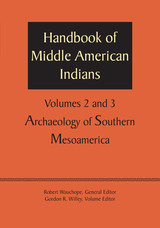
Archaeology of Southern Mesoamerica comprises the second and third volumes in the Handbook of Middle American Indians, published in cooperation with the Middle American Research Institute of Tulane University under the general editorship of Robert Wauchope (1909–1979). The volume editor is Gordon R. Willey (1913–2002), Bowditch Professor of Mexican and Central American Archaeology and Ethnology at Harvard University.
Volumes Two and Three, with more than 700 illustrations, contain archaeological syntheses, followed by special articles on settlement patterns, architecture, funerary practices, ceramics, artifacts, sculpture, painting, figurines, jades, textiles, minor arts, calendars, hieroglyphic writing, and native societies at the time of the Spanish conquest of the Guatemala highlands, the southern Maya lowlands, the Pacific coast of Guatemala, Chiapas, the upper Grijalva basin, southern Veracruz, Tabasco, and Oaxaca.
The Handbook of Middle American Indians was assembled and edited at the Middle American Research Institute of Tulane University with the assistance of grants from the National Science Foundation and under the sponsorship of the National Research Council Committee on Latin American Anthropology.
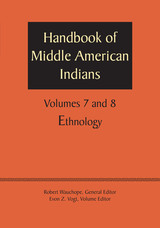
Ethnology comprises the seventh and eighth volumes in the Handbook of Middle American Indians, published in cooperation with the Middle American Research Institute of Tulane University under the general editorship of Robert Wauchope (1909–1979). The editor of the Ethnology volumes is Evon Z. Vogt (1918–2004), Professor of Anthropology in the Department of Social Relations, Harvard University.
These two books contain forty-three articles, all written by authorities in their field, on the ethnology of the Maya region, the southern Mexican highlands and adjacent regions, the central Mexican highlands, western Mexico, and northwest Mexico. Among the topics described for each group of Indians are the history of ethnological investigations, cultural and linguistic distributions, major postcontact events, population, subsistence systems and food patterns, settlement patterns, technology, economy, social organization, religion and world view, aesthetic and recreational patterns, life cycle and personality development, and annual cycle of life.
The volumes are illustrated with photographs and drawings of contemporary and early historical scenes of native Indian life in Mexico and Central America.
The Handbook of Middle American Indians was assembled and edited at the Middle American Research Institute of Tulane University with the assistance of grants from the National Science Foundation and under the sponsorship of the National Research Council Committee on Latin American Anthropology.
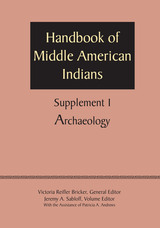
The sixteen-volume Handbook of Middle American Indians, completed in 1976, has been acclaimed the world over as the most valuable resource ever produced for those involved in the study of Mesoamerica. When it was determined in 1978 that the Handbook should be updated periodically, Victoria Reifler Bricker, well-known cultural anthropologist, was selected to be series editor.
This first volume of the Supplement is devoted to the dramatic changes that have taken place in the field of archaeology. The volume editor, Jeremy A. Sabloff, has gathered together detailed reports from the directors of many of the most significant archaeological projects of the mid-twentieth century in Mesoamerica, along with discussions of three topics of general interest (the rise of sedentary life, the evolution of complex culture, and the rise of cities).
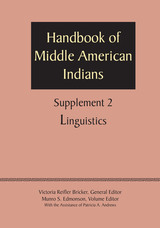
The sixteen-volume Handbook of Middle American Indians, completed in 1976, has been acclaimed the world over as the single most valuable resource ever produced for those involved in the study of Mesoamerica. When it was determined in 1978 that the Handbook should be updated periodically, well-known cultural anthropologist Victoria Reifler Bricker was selected to be general editor.
This second volume of the Supplement is devoted to Mesoamerican languages. It differs in both scope and content from its forerunner, Volume 5 of the Handbook of Middle American Indians: Linguistics, which presents a general survey of Middle American linguistics and descriptions of Classical Nahuatl, Yucatec, Quiche, Popoluca, Zapotec, Mazatec, Pame, and Chontal de Oaxaca.
The aim of the present volume is to provide detailed sketches of five additional languages: Mixe, Chichimeco Jonaz, Choltí, Tarascan, and Huastec. All the grammatical sketches deal with the phonology, morphology, and syntax of the languages treated; most cover discourse as well. Taken together, these new essays represent a substantial enrichment of the earlier Handbook volume on linguistics. Alone, the Supplement stands as an invaluable reference guide for all who are interested in learning about these important and heretofore poorly treated languages of Middle America.
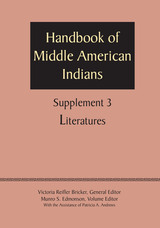
Munro S. Edmonson, volume editor
The sixteen-volume Handbook of Middle American Indians, completed in 1976, has been acclaimed the world over as the single most valuable resource ever produced for those involved in the study of Mesoamerica. When it was determined in 1978 that the Handbook should be updated periodically, Victoria Reifler Bricker, well-known cultural anthropologist, was elected to be general editor.
This third volume of the Supplement is devoted to the aboriginal literatures of Mesoamerica, a topic receiving little attention in the original Handbook. According to the general editor, "This volume does more than supplement and update the coverage of Middle American Indian literatures in the Handbook. It breaks new ground by defining the parameters of a new interdisciplinary field in Middle American Indian studies."
The aim of the present volume is to consider literature from five Middle American Indian languages: Nahuatl, Yucatecan Maya, Quiche, Tzotzil, and Chorti. The first three literatures are well documented for both the Classical and Modern variants of their languages and are obvious candidates for inclusion in this volume. The literatures of Tzotzil and Chorti, on the other hand, are oral, and heretofore little has been written of their genres and styles.
Taken together, these essays represent a substantial contribution to the Handbook series, with the volume editor's introduction placing in geographic perspective the five literatures chosen as representative of the Middle American literary tradition.
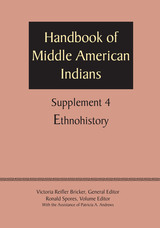
Ronald Spores, volume editor
The sixteen-volume Handbook of Middle American Indians, completed in 1976, has been acclaimed the world over as the single most valuable resource ever produced for those involved in the study of Mesoamerica. When it was determined in 1978 that the Handbook should be updated periodically, Victoria Reifler Bricker, well-known cultural anthropologist, was elected to be general editor.
This fourth volume of the Supplement is devoted to colonial ethnohistory. Four of the eleven chapters review research and ethnohistorical resources for Guatemala, South Yucatan, North Yucatan, and Oaxaca, areas that received less attention than the central Mexican area in the original Guide to Ethnohistorical Sources (HMAI vols. 12-15).
Six substantive and problem-oriented studies cover the use of colonial texts in the study of pre-colonial Mayan languages; political and economic organization in the valleys of Mexico, Puebla-Tlaxcala, and Morelos; urban-rural relations in the Basin of Mexico; kinship and social organization in colonial Tenochtitlan; tlamemes and transport in colonial central Mexico; and land tenure and titles in central Mexico as reflected in colonial codices.
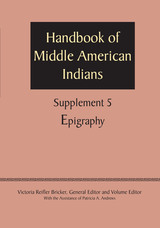
In 1981, under the editorship of Victoria Bricker, UT Press began to issue supplemental volumes to the classic sixteen-volume work Handbook of Middle American Indians. These supplements are intended to update scholarship in various areas and to cover topics of current interest that may not have been included in the original Handbook.
This volume is designed to recognize the important role that epigraphy has come to play in Middle American scholarship and to document significant achievements in three areas: dynastic history, phonetic decipherment, and calendrics. The book covers four of the major pre-Columbian scripts in the region (Zapotec, Mixtec, Aztec, and Maya) and one that is relatively unknown (Tlapanec).
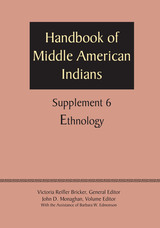
In 1981, UT Press began to issue supplemental volumes to the classic sixteen-volume work, Handbook of Middle American Indians. These supplements are intended to update scholarship in various areas and to cover topics of current interest. Supplements devoted to Archaeology, Linguistics, Literatures, Ethnohistory, and Epigraphy have appeared to date.
In this Ethnology supplement, anthropologists who have carried out long-term fieldwork among indigenous people review the ethnographic literature in the various regions of Middle America and discuss the theoretical and methodological orientations that have framed the work of areal scholars over the last several decades. They examine how research agendas have developed in relationship to broader interests in the field and the ways in which the anthropology of the region has responded to the sociopolitical and economic policies of Mexico and Guatemala. Most importantly, they focus on the changing conditions of life of the indigenous peoples of Mesoamerica. This volume thus offers a comprehensive picture of both the indigenous populations and developments in the anthropology of the region over the last thirty years.
READERS
Browse our collection.
PUBLISHERS
See BiblioVault's publisher services.
STUDENT SERVICES
Files for college accessibility offices.
UChicago Accessibility Resources
home | accessibility | search | about | contact us
BiblioVault ® 2001 - 2024
The University of Chicago Press









